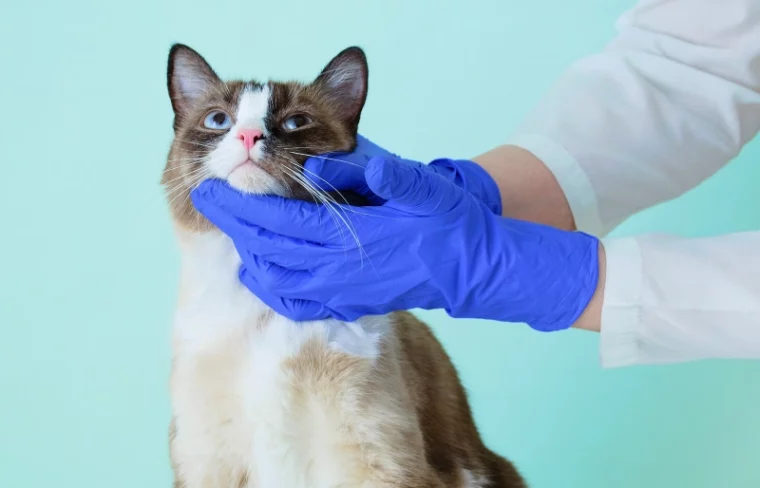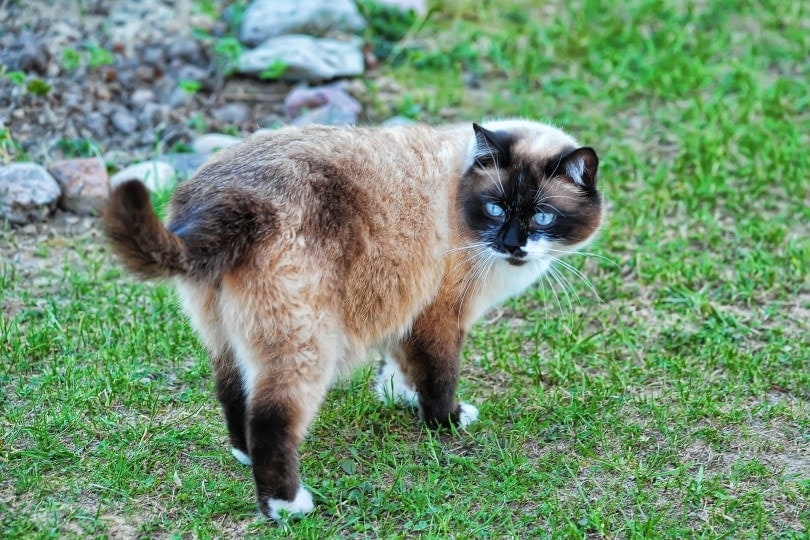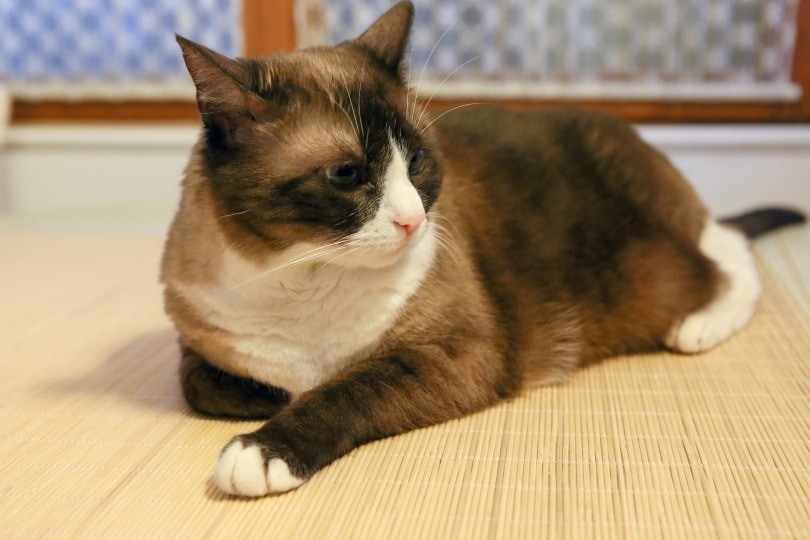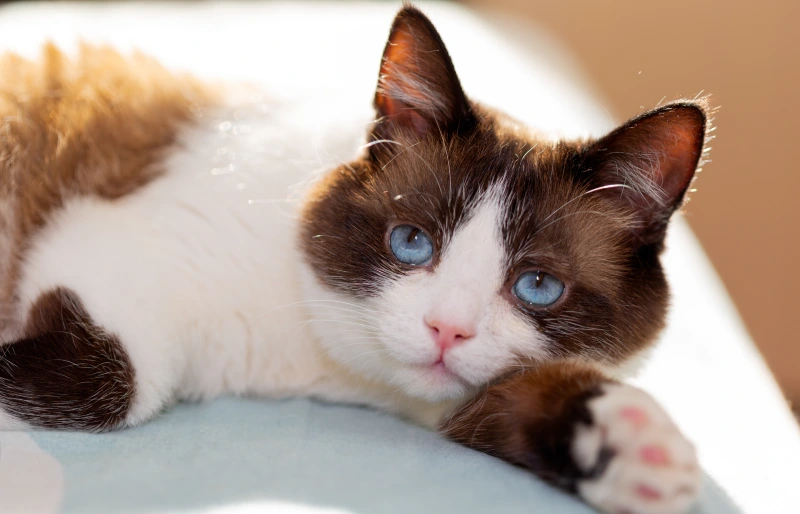
A Snowshoe cat is a cross between a Siamese and an American Shorthair cat. They’re medium-sized cats with bright-blue eyes and dark masks on their faces. They come in traditional Siamese pointed colors but have white feet, making them appear to be wearing white mittens. These feet give this adorable cat their Snowshoe name.
The Snowshoe cat is a relatively healthy one. They don’t seem to suffer from many genetic conditions, and they have long lifespans. However, as with any cat, there are many health problems possible. Here are a few of those more common health problems to be aware of so you can identify their signs.
If you own this breed, you should know what to look for to make sure your cat stays as healthy as possible.
The 5 Health Concerns of Snowshoe Cats
If you own a Snowshoe cat, do know that these health conditions may or may not be present at any point in your cat’s lifetime. These are not guaranteed to affect Snowshoe cats, but they are possibilities. It’s important to know what these conditions are so you can be prepared in case they appear.
1. Renal Failure
Renal failure means the kidneys have stopped functioning normally. Since the kidneys are responsible for filtering waste from the blood, this failure causes a buildup of toxins and wastes in the bloodstream. It’s also responsible for an imbalance of electrolytes, dehydration, and an imbalance of the acid-base in the blood.
Signs
Signs of renal failure in cats include vomiting, lethargy, weight loss, dull coat, diarrhea, refusal to eat, and an ammonia-like odor to the breath. Some cats also see a decrease in urination, while others see an increase. It’s important to get your cat to the vet as soon as signs start because many cats are already in a degree of kidney failure by the time they are showing symptoms. If the condition is chronic, the cat’s health will determine the course of treatment.
Treatment
If the cat’s renal failure is acute, meaning that it happens with an identifiable cause, it can be reversed in many cases with prompt treatment. Acute renal failure can be caused by several things, including poisoning, ingestion of toxins, bacterial kidney infections, low blood pressure, and systemic shock. Your vet will try to remove the toxins from the bloodstream and restore the electrolyte balance. Fluids, medications, and nutritional support may be administered to help the cat recover.
In cases of chronic renal failure that usually occurs with age, there is no cure. But if the condition is caught early enough, it can be managed with supportive care, like fluids and medications. The cat may also need a specialized diet.
Snowshoe cats are more prone to polycystic kidney disease (PKD), which is an inherited disease causing gradual loss of function of the kidneys due to the development of multiple fluid-filled cysts.

2. Progressive Retinal Atrophy
Progressive retinal atrophy affects the photoreceptor cells in a cat’s eye. These photoreceptors, located in the retina, are responsible for sending electrical signals to the brain that decipher what is seen. This disease means the photoreceptor cells atrophy or deteriorate over time. Eventually, this will cause blindness in the cat.
Signs
Since this condition doesn’t cause pain, it can be hard to notice if it’s developing in your Snowshoe cat. The first thing that usually happens is your cat loses the ability to see at night. Since cats are known to see in the dark, this is a tell-tale, noticeable sign. Cats will be reluctant to go into dark spaces and may bump into objects in dimly lit areas. In some cases, the condition isn’t noticed until the cat is completely blind.
Treatment
There is no treatment for progressive retinal atrophy. Cats can adjust to life without sight. Keeping the layout of the house the same and not moving furniture or the cat’s litter box or food bowls will be necessary to help them navigate their space and live as normally as possible. Knowing that the condition is occurring can give you time to help your cat adjust and feel safe.
3. Heart Disease
Snowshoe cats can develop heart disease over time, or they can be born with the condition due to a malformation of the heart before birth. As adults, cats can experience heart disease as a result of damage to the heart muscle that causes it to function abnormally. In other cases, the damage to the heart is caused by another health condition in the cat’s body such as an overactive thyroid gland.
Signs
Heart disease can be difficult to detect in cats as they do not always show outward signs. Cats will tend to sleep more and become more withdrawn, but these signs can go unnoticed for long periods. They may become less interested in being active and may stop playing like they once did and sometimes will develop a cough.
Other more obvious signs include weight loss, appetite loss, increased breathing rate, and hind leg paralysis caused by blood clots.
Treatment
The treatment for your cat’s heart disease will depend on the cause of the condition. In some cases, genetic defects can be fixed with surgery. Sometimes the cat will just need to be monitored to make sure the condition doesn’t get any worse. In extreme cases, supportive care will be necessary, including a specialized diet and medication.

4. Hyperthyroidism
Siamese cats are at a greater risk of developing hyperthyroidism. Since Snowshoe cats were bred from Siamese cats, this is a condition to know about. Hyperthyroidism is common in older cats. It means the thyroid glands, responsible for metabolism, are overproducing hormones. The metabolism is sped up and cats lose weight even though they may have a ravenous appetite. Hyperthyroidism does affect the function of the heart and other organs.
Signs
Signs of hyperthyroidism include unexplained weight loss, increased appetite, aggression, restlessness, and increased vocalization. As the disease progresses, cats can experience vomiting, diarrhea, and appetite loss.
Treatment
Fortunately, the treatment of hyperthyroidism is usually successful. Once a diagnosis has been made, many cats are prescribed an oral medication that they will take daily for the rest of their lives. In other cases, surgery to remove the thyroid glands is recommended, as this is often a cure. Some cats will require a specialized diet to control their levels of iodine.
Radioactive iodine injections can be used in place of daily medications. Your cat will receive an injection of this iodine that destroys abnormal thyroid tissue. However, this treatment is intensive and only offered at specialist centers. Cats will need to be hospitalized for 1–2 weeks for the treatment, and it’s usually a costly option.
5. Diabetes Mellitus
Cats that do not produce enough insulin to convert the sugar in their blood into energy have diabetes mellitus. Their pancreas is failing to regulate the blood sugar in the body. This means there will be an excess of glucose in the blood.
Signs
The major symptoms of diabetes mellitus are increased appetite, weight loss, increased thirst, and increased urination. These signs can be difficult to detect. Diabetes mellitus is the second most common endocrine disease that cats can have. Your vet will diagnose this condition through a specialized test that measures blood glucose levels. Cats with normal blood sugar levels will not have glucose in their urine. Urine tests may also help diagnose this condition.
Treatment
Diabetes mellitus is treatable. Many cats require insulin injections that are easy to administer at home once your vet shows you how to do it. Ongoing monitoring will be necessary by your vet to make sure the cat’s glucose level is normal. In some cases, weight loss will be recommended, along with a specialized diet.

Keeping Your Snowshoe Cat Healthy
If you notice any changes in your cat’s behavior or any signs of the health conditions in this article, take your cat to the vet for an exam. The best way to keep your cat healthy is to keep up with their annual vet appointments and preventative health care.
As your vet examines your cat each year, they can notice any changes in their physical health and talk to you about the cat’s activities and behavior. Your cat will also need to be up to date on all vaccines to prevent diseases like rabies and feline distemper.
Your cat should be up to date on all flea, tick, and heartworm preventions even if they live strictly indoors. The insects that cause internal parasites, like heartworm disease, can still get into your home.
Feed your cat a healthy, high-quality, meat-based diet. Cats are obligate carnivores and require protein from animal sources in their food. Brush your cat often, keep them clean, and watch for any changes in their appearance or daily life.

Conclusion
Snowshoe cats are generally healthy cats that make loving additions to any home. By knowing the signs of their potential health problems, you can get them diagnosed and treated as quickly as possible. Sometimes, early treatment can give the cats the best chance at recovery or disease management. Keep up with your yearly vet appointments to ensure that your Snowshoe cat stays happy and healthy for years to come.
Featured Image Credit: Yuliya Alekseeva, Shutterstock







